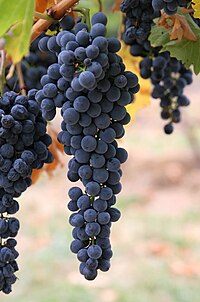
Photo from wikipedia
Reducing pesticide use is a major challenge in agriculture, and farmers are encouraged to develop integrated practices. The aim of this study was to describe, analyse and assess the current… Click to show full abstract
Reducing pesticide use is a major challenge in agriculture, and farmers are encouraged to develop integrated practices. The aim of this study was to describe, analyse and assess the current contribution of various options to pest, disease and weed management on the reduction of fungicides, herbicides and insecticides by quantifying both their use and their effect on pesticide use intensity, within the context of different wine-growing regions. We conducted a statistical analysis of pesticide use and crop management over two seasons (2006 and 2010) for 11 French wine-growing regions (10,000 data). We used the Treatment Frequency Index (TFI) indicator to characterise the intensity of pesticide use. We analysed three crop management options: timing of first fungicide spray, type of soil cover cropping, and type of weed control. For each management option, we compared alternative or low-input practices to normal chemical-based practices, e.g., mechanical weed control (alternative option) vs. herbicide (normal chemical option). To strengthen the results, two quantitative variables completed the analysis: fungicide mean sprayed dose in the field and number of fungicides sprayed in the field. Results showed that each alternative or low input practice had an impact on TFI, but that this impact differed between wine-growing regions and between the management options under consideration. Regarding fungicides, our results showed that late timing of first fungicide spray (compared to regional reference) contributed to a reduction up to 50% of the part of the TFI due to fungicides, as compared to fields sprayed at median or early timing. Regarding herbicides, results of low-input/alternative practices were more homogeneous in terms of their relative impact on TFI reduction. The differences in use and impact of crop protection practices were more important between regions than between the two studied years. Our results may help policy makers to target methods for decreasing pesticide use, based on particularities of wine-growing regions and locally realistic practices.
Journal Title: European Journal of Agronomy
Year Published: 2017
Link to full text (if available)
Share on Social Media: Sign Up to like & get
recommendations!